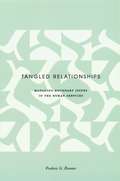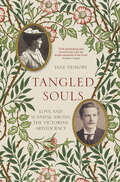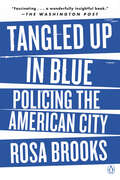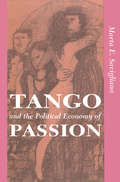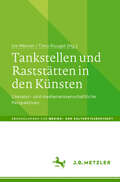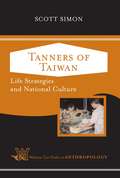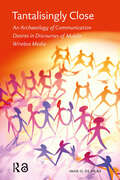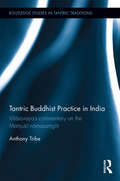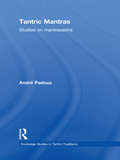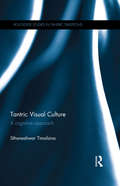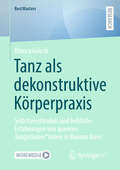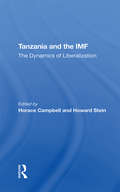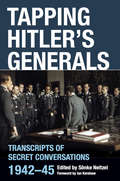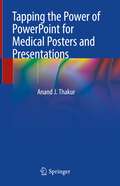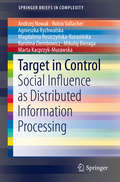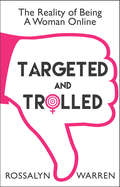- Table View
- List View
Tangled Relationships: Boundary Issues and Dual Relationships in the Human Services (Foundations of Social Work Knowledge Series)
by Frederic G. ReamerShould a therapist counsel a former lover or accept a client's gift? If so, has a boundary been crossed? Some boundary issues, like beginning a sexual relationship with a client, are obvious pitfalls to avoid, but what about more subtle issues, like hugging a client or disclosing personal information to a client? What are the boundaries of maintaining a friendship with a former client or the relative of a client? When do conflicts of interest overburden the client-practitioner relationship?Frederic Reamer, a leading authority on professional ethics, offers a definitive and up-to-date analysis of boundary issues, a rapidly emerging topic in the field of human services. One of the only works in the field to provide a conceptual framework for the dual relationship between practitioner and client, this book provides an in-depth look at the complex forms these relationships take. It also gives practical risk-management models to aid human service professionals in the prevention of problematic situations and the managing of dual relationships. Reamer examines the ethics involving intimate and sexual relationships with clients and former clients, practitioners' self-disclosure, giving and receiving favors and gifts, bartering for services, and unavoidable and unanticipated circumstances such as social encounters and geographical proximity. Case vignettes that help illustrate important points are also included in each chapter.
Tangled Souls: Love and Scandal Among the Victorian Aristocracy
by Jane Dismore'With painstaking skill, Dismore lays bare the double standards of the Souls - a brilliant group who thought themselves superior, in morals and intellect, to the rest of their class' Artemis Cooper'Harry Cust has long needed to emerge from the shadows. A rich tapestry unfolds' Hugo Vickers?Outrageously handsome, witty and clever, Harry Cust was reputed to be one of the great womanisers of the late Victorian era. In 1893, while a Member of Parliament, he caused public scandal by his affair with artist and poet Nina Welby Gregory. When she revealed she was pregnant, horror swept through their circle known as ‘the Souls’, a cultured, mostly aristocratic group of writers, artists and politicians who also rubbed shoulders with luminaries such as Oscar Wilde and H. G. Wells.With the unconventional Margot Tennant and philosopher-statesman Arthur Balfour at their centre, the dazzling Souls eschewed the formalities of upper-class etiquette, valuing conversation and clever games above gambling and racing. Talented and glamorous women such as Violet Granby and Ettie Grenfell joined rising politicians George Curzon and George Wyndham at grand country houses to talk, play and flirt.Passions raged behind their courtly code. Married Souls discreetly bore their lovers’ children – and public figures got away with much worse – yet bachelor Harry’s seduction of a single woman of the same class broke the rules. For the rest of their lives, Harry and Nina would fight to rebuild their reputations and maintain the marriage they were pressurised to enter.In Tangled Souls, acclaimed biographer Jane Dismore tells the tumultuous story of the romance which threatened to tear apart this distinguished group of friends, revealing pre-war society at its most colourful and most conflicted.
Tangled Up in Blue: Policing the American City
by Rosa BrooksJournalist and law professor Rosa Brooks goes beyond the "blue wall of silence" in this radical inside examination of American policingIn her forties, with two children, a spouse, a dog, a mortgage, and a full-time job as a tenured law professor at Georgetown University, Rosa Brooks decided to become a cop. A liberal academic and journalist with an enduring interest in law's troubled relationship with violence, Brooks wanted the kind of insider experience that would help her understand how police officers make sense of their world—and whether that world can be changed. In 2015, against the advice of everyone she knew, she applied to become a sworn, armed reserve police officer with the Washington, DC, Metropolitan Police Department.Then as now, police violence was constantly in the news. The Black Lives Matter movement was gaining momentum, protests wracked America's cities, and each day brought more stories of cruel, corrupt cops, police violence, and the racial disparities that mar our criminal justice system. Lines were being drawn, and people were taking sides. But as Brooks made her way through the police academy and began work as a patrol officer in the poorest, most crime-ridden neighborhoods of the nation's capital, she found a reality far more complex than the headlines suggested.In Tangled Up in Blue, Brooks recounts her experiences inside the usually closed world of policing. From street shootings and domestic violence calls to the behind-the-scenes police work during Donald Trump's 2016 presidential inauguration, Brooks presents a revelatory account of what it's like inside the "blue wall of silence." She issues an urgent call for new laws and institutions, and argues that in a nation increasingly divided by race, class, ethnicity, geography, and ideology, a truly transformative approach to policing requires us to move beyond sound bites, slogans, and stereotypes. An explosive and groundbreaking investigation, Tangled Up in Blue complicates matters rather than simplifies them, and gives pause both to those who think police can do no wrong—and those who think they can do no right.
Tango And The Political Economy Of Passion (Institutional Structures of Feeling)
by Marta SaviglianoWhat is tango? Dance, music, and lyrics of course, but also a philosophy, a strategy, a commodity, even a disease. This book explores the politics of tango, tracing tango's travels from the brothels of Buenos Aires to the cabarets of Paris and the shako dansu clubs of Tokyo. The author is an Argentinean political theorist and a dance professor at the University of California at Riverside. She uses her ?tango tongue? to tell interwoven tales of sexuality, gender, race, class, and national identity. Along the way she unravels relations between machismo and colonialism, postmodernism and patriarchy, exoticism and commodification. In the end she arrives at a discourse on decolonization as intellectual ?unlearning.?Marta Savigliano's voice is highly personal and political. Her account is at once about the exoticization of tango and about her own fate as a Third World woman intellectual. A few sentences from the preface are indicative: ?Tango is my womb and my tongue, a trench where I can shelter and resist the colonial invitations to '`'universalism,'? a stubborn fatalist mood when technocrats and theorists offer optimistic and seriously revised versions of '`'alternatives' for the Third World, an opportunistic metaphor to talk about myself and my stories as a success' of the civilization-development-colonization of Am�ca Latina, and a strategy to figure out through the history of the tango a hooked-up story of people like myself. Tango is my changing, resourceful source of identity. And because I am where I am?outside?tango hurts and comforts me: '`'Tango is a sad thought that can be danced.'?Savigliano employs the tools of ethnography, history, body-movement analysis, and political economy. Well illustrated with drawings and photos dating back to the 1880s, this book is highly readable, entertaining, and provocative. It is sure to be recognized as an important contribution in the fields of cultural studies, performance studies, decolonization, and women-of-color feminism.
Tango and the Dancing Body in Istanbul (Routledge Advances in Theatre & Performance Studies)
by Melin Levent YunaTango and the Dancing Body in Istanbul explores the expansion of social Argentine tango dancing among Muslim actors in Turkey, pioneered in Istanbul despite the conservative rule of the Justice and Development Party (JDP) and Tayyip Erdoğan. In this book, Melin Levent Yuna questions why a dance that appears to publicly represent an erotic relationship finds space to expand and increase dramatically in the number of contemporary Turkish Muslim tango dancers, particularly during a conservative rule. Even during the 2020 Covid-19 pandemic, tango dance classes, gatherings, and messages flourished on YouTube, Facebook, Instagram, and Zoom. Urban Turkey and its tango dance performances provide one symbol and example of how neoliberal capitalism could go hand in hand with conservatism by becoming a bridge between Europe and the Middle East. This study largely focuses on the dancers’ perspective while presenting the policies of Erdoğan. It presents the social characteristics of the tango dancers, the meanings they attach to their bodies and their dance as well as what this dance reflects about them – besides the policies of the Justice and Development Party. The book approaches the tango dance and its dancing body in terms of layers of meaning systems in a neoliberal and conservative context. This study will be of great interest to students and scholars in dance, anthropology, cultural studies, and performance studies.
Tankstellen und Raststätten in den Künsten: Literatur- und medienwissenschaftliche Perspektiven (Abhandlungen zur Medien- und Kulturwissenschaft)
by Iris Meinen Timo RougetTankstellen und Raststätten sind omnipräsente Orte industrialisierter Kulturen, an denen sich die Diskurse ihrer Zeit verdichten. Aus der Kombination – Orte des Zeitgeistes und der Alltagswelt – speist sich ihre hohe Anschlussfähigkeit für die Künste. Die Thematisierungen reichen von Hoch- bis Populärkultur, vom frühen 20. Jahrhundert bis zur Gegenwart. Der vorliegende Band konturiert Tankstellen und Raststätten erstmalig als Gegenstand geistes- und kulturwissenschaftlicher Forschung, benennt theoretische wie methodische Zugänge und präsentiert neben Überblicksdarstellungen und exemplarischen Einzelfallstudien eine umfangreiche Beispielsammlung.
Tanners of Taiwan
by Scott SimonIn this book, which began as the Simon's (sociology, U. of Ottawa, Canada) dissertation, an ethnography of workers and managers in leather tanning factories in southern Taiwan is presented, with a focus on identity, nationalism, and political dimensions of their culture. Aimed at undergraduates, the book considers whether Taiwan is a Chinese or Taiwanese culture, provides a national and political context, describes social life and the influence of the Chinese National Party, and discusses family firms and corporations in the leather tanning industry and their relationship to cultural and national narratives about identity. The author then addresses these firms from the female perspective, and examines the labor movement, effects of tanners moving abroad, and the use of the electoral system following the end of martial law to create an independent Taiwan. Annotation ©2006 Book News, Inc. , Portland, OR (booknews. com)
Tanners of Taiwan
by Scott SimonTanners of Taiwan is an ethnography of identity construction set in the leather-tanning communities of Southern Taiwan. Through life history analysis and ethnographic observation, Simon examines what it means to be Chinese - or alternatively Taiwanese - in contemporary Taiwan. Under forty years of martial law from 1947 to 1987, the Chinese Nationalist Party tried to create a Chinese identity in Taiwan through ideological campaigns that reached deep into families, schools and workplaces. They justified their rule through a development narrative that Chinese culture and good policy contributed to the prosperity of the Taiwan miracle. These ideological claims and cultural identities, however, have never been fully accepted in Southern Taiwan. This ethnography is the first to document from the ground level how those claims have been contested, and how a new Taiwanese identity has been constructed since democratization. Tanners of Taiwan provides more than a description of workplaces in Taiwan. Looking at the different perspectives of tanners, women managers, and workers, it demonstrates how cultural and other identities are constructed through dynamics of power and political economy. A small, affordable case studies book to be assigned with a core textbook in introductory anthropology courses. Shows how the US reader is connected to the seemingly distant lives of Taiwanese tanners. Simon follows hides from the US to tanneries in Taiwan, then elsewhere to be made into shoes and other leather goods, and then back to the consumer in the US - demonstrating concretely the notion of "global interconnectedness." Anchored in personal observation and ethnographic detail, the book makes very tangible such otherwise abstract notions as "national identity" and "global integration."
Tanners of Taiwan
by Scott SimonTanners of Taiwan is an ethnography of identity construction set in the leather-tanning communities of Southern Taiwan. Through life history analysis and ethnographic observation, Simon examines what it means to be Chinese - or alternatively Taiwanese - in contemporary Taiwan. Under forty years of martial law from 1947 to 1987, the Chinese Nationalist Party tried to create a Chinese identity in Taiwan through ideological campaigns that reached deep into families, schools and workplaces. They justified their rule through a development narrative that Chinese culture and good policy contributed to the prosperity of the Taiwan miracle. These ideological claims and cultural identities, however, have never been fully accepted in Southern Taiwan. This ethnography is the first to document from the ground level how those claims have been contested, and how a new Taiwanese identity has been constructed since democratization. Tanners of Taiwan provides more than a description of workplaces in Taiwan. Looking at the different perspectives of tanners, women managers, and workers, it demonstrates how cultural and other identities are constructed through dynamics of power and political economy. A small, affordable case studies book to be assigned with a core textbook in introductory anthropology courses. Shows how the US reader is connected to the seemingly distant lives of Taiwanese tanners. Simon follows hides from the US to tanneries in Taiwan, then elsewhere to be made into shoes and other leather goods, and then back to the consumer in the US - demonstrating concretely the notion of "global interconnectedness. " Anchored in personal observation and ethnographic detail, the book makes very tangible such otherwise abstract notions as "national identity" and "global integration. "
Tantalisingly Close: An Archaeology of Communication Desires in Discourses of Mobile Wireless Media (MediaMatters)
by Imar VriesWhile studies of mobile wireless communication devices usually focus on their social implications, De Vries proposes to venture into a more historical and comparative direction to shed light on our preoccupation with them in the first place. He constructs an archaeological view of the development of communication technologies over the past 200 years, providing a comprehensive account of how persistent hopes and beliefs have come to give mobile wireless media such a prominent position today. Our expectations and uses of them are surprisingly similar to those of older media; consequently, they reconfirm the idea that living in an ‘anyone, anything, anytime, anywhere’ world is both a blessing and a curse, and that the desire for sublime communication is a tragic yet highly powerful regulative principle in our media evolution.
Tantra, Magic, and Vernacular Religions in Monsoon Asia: Texts, Practices, and Practitioners from the Margins (Routledge Studies in Tantric Traditions)
by Andrea Acri Paolo E. RosatiThis book explores the cross- and trans-cultural dialectic between Tantra and intersecting ‘magical’ and ‘shamanic’ practices associated with vernacular religions across Monsoon Asia. With a chronological frame going from the mediaeval Indic period up to the present, a wide geographical framework, and through the dialogue between various disciplines, it presents a coherent enquiry shedding light on practices and practitioners that have been frequently alienated in the elitist discourse of mainstream Indic religions and equally overlooked by modern scholarship. The book addresses three desiderata in the field of Tantric Studies: it fills a gap in the historical modelling of Tantra; it extends the geographical parameters of Tantra to the vast, yet culturally interlinked, socio-geographical construct of Monsoon Asia; it explores Tantra as an interface between the Sanskritic elite and the folk, the vernacular, the magical, and the shamanic, thereby revisiting the intellectual and historically fallacious divide between cosmopolitan Sanskritic and vernacular local. The book offers a highly innovative contribution to the field of Tantric Studies and, more generally, South and Southeast Asian religions, by breaking traditional disciplinary boundaries. Its variety of disciplinary approaches makes it attractive to both the textual/diachronic and ethnographic/synchronic dimensions. It will be of interest to specialist and non-specialist academic readers, including scholars and students of South Asian religions, mainly Hinduism and Buddhism, Tantric traditions, and Southeast Asian religions, as well as Asian and global folk religion, shamanism, and magic.
Tantric Buddhist Practice in India: Vilāsavajra’s commentary on the Mañjuśrī-nāmasaṃgīti (Routledge Studies in Tantric Traditions)
by Anthony TribeUsing a commentary on the influential text, the Mañjuśrī-nāmasaṃgīti, ‘The Chanting of the Names of Mañjuśrī’, this book deals with Buddhist tantric meditation practice and its doctrinal context in early-medieval India. The commentary was written by the 8th-9th century Indian tantric scholar Vilāsavajra, and the book contains a translation of the first five chapters. The translation is extensively annotated, and accompanied by introductions as well as a critical edition of the Sanskrit text based on eight Sanskrit manuscripts and two blockprint editions of the commentary’s Tibetan translation. The commentary interprets its root text within an elaborate framework of tantric visualisation and meditation that is based on an expanded form of the Buddhist Yoga Tantra mandala, the Vajradhātu-maṇḍala. At its heart is the figure of Mañjuśrī, no longer the familiar bodhisattva of wisdom, but now the embodiment of the awakened non-dual gnosis that underlies all Buddhas as well their activity in the cosmos. The book contributes to our understanding of the history of Indian tantric Buddhism in a period of significant change and innovation. With its extensively annotated translation and lengthy introductions the book is designed to appeal not only to professional scholars and research students but also to contemporary Buddhists.
Tantric Mantras: Studies on Mantrasastra (Routledge Studies in Tantric Traditions)
by Andre PadouxProviding a systematic and complete overview of the highest scholarly quality on Tantric mantras in Hinduism, this book presents a summary on the nature of Tantric mantras, their phonetic aspect, structure and classifications. Additionally, it explains the metaphysical-theological nature of Tantric mantras and gives an introduction to their beliefs and practices. In individual chapters, Andre Padoux discusses the extraction and examination of mantras, certain characteristics such as their "perfect nature" and their imperfections, and he describes certain mantrics practices. For the first time, Andre Padoux' work on Tantric mantras is made accessible to an English-speaking readership. This book will be of great interest to scholars of Religious Studies, Theology, Indology, South Asian Studies, and Asian Religion.
Tantric Visual Culture: A Cognitive Approach (Routledge Studies in Tantric Traditions)
by Sthaneshwar TimalsinaIndian culture relies greatly on visual expression, and this book uses both classical Indian and contemporary Western philosophies and current studies on cognitive sciences, and applies them to contextualize Tantric visual culture. The work selects aspects of Tantric language and the practice of visualization, with the central premise to engage cognitive theories while studying images. It utilizes the contemporary theories of metaphor and cognitive blend, the theory of metonymy, and a holographic theory of epistemology with a focus on concept formation and its application to the study of myths and images. In addition, it applies the classical aesthetic theory of rasa to unravel the meaning of opaque images. This philosophical and cognitive analysis allows materials from Indian culture to be understood in a new light, while engaging contemporary theories of cognitive science and semantics. The book demonstrates how the domains of meaning and philosophy can be addressed within any culture without reducing their intrinsic cultural significance. By addressing these key aspects of Tantric traditions through this approach, this book initiates a much-needed dialogue between Indian and Western theories, while encouraging introspection within the Indic traditions themselves. It will be of interest to those studying and researching Religion, Philosophy and South Asian Culture.
Tanz als dekonstruktive Körperpraxis: Selbstverständnis und leibliche Erfahrungen von queeren Tangotänzer*innen in Buenos Aires (BestMasters)
by Bianca GriechIn der kulturellen Praxis des Tango Argentino wird die Semantik einer Überschneidung hegemonialer Diskurse sichtbar, die insbesondere durch binäre Geschlechterrollen und heteronormative Performanz gekennzeichnet sind. Im Kontext der leidenschaftlichen und emotionalen Begegnungen des Tangos, die nicht selten von erotischen Spannungen durchzogen sind, entfaltet sich ein Diskurs, der die heteronormative Konstruktion der tanzenden Körper vermittelt. Ausgehend von der Betrachtung des Tangos als Bewegungspraxis, die in einem symbolisch-diskursiven Feld verortet ist, das den Konstitutionsrahmen für Körper und deren Bewegungen im Tanz schafft, untersucht die vorliegende Arbeit vor dem Hintergrund der Queer Theory und Ansätzen der feministischen Phänomenologie das Verhältnis zwischen dem Diskurs der Geschlechterdifferenz und der körperlich-leiblichen Erfahrung queerer Tangotänzer*innen. Im Zentrum steht dabei die Frage, auf welche Weise heteronormative Strukturen, die in der Tangokultur vorherrschen, im Sinne queerer Subversion dekonstruiert werden. Das Erkenntnisinteresse dieser Arbeit liegt darin zu verstehen, wie sich queeres Selbstverständnis im Tango manifestiert, in welchen Elementen des Tangos sich Performativität und die diskursive Konstitution von Geschlechterrollen widerspiegeln und wie queere Tangotänzer*innen in Bezug darauf den Tanz auf der körperlichen Ebene erfahren.
Tanzania And The Imf: The Dynamics Of Liberalization
by Howard Stein Joel Samoff Horace CampbellThe recent debate on the consequences of structural adjustment for developing economies, which took place between the World Bank and the United Nation's Economic Commission on Africa, underlines the need for further investigation of this important economic strategy. Tanzania, which for a decade had stood as a symbol of opposition to the Internation
Tanzania: An African Experiment
by Rodger YeagerThis book provides an overview of Tanzania, one of Africa's economically most distressed, socially most innovative, and politically most controversial countries. Focusing on the last three decades, it glimpses into the rich Tanzanian past and reflects influences from the world's major cultures.
Tapestry Conservation: Principles and Practice
by Maria Hayward Frances LennardTapestry Conservation: Principles and Practice explores current practice and recent research in tapestry conservation, promoting awareness of recent developments among conservators and custodians of tapestries. The book facilitates more informed conservation practice and decision-making, and helps custodians to select the most appropriate method of intervention.
Tapping Hitler's Generals: Transcripts of Secret Conversations, 1942–45
by Sönke NeitzelThese transcripts of wiretapped conversations between Nazi officers reveal &“a fascinating—and chilling—insight into the German view of the war&” (Financial Times). Between 1939 and 1942, the British Directorate of Military Intelligence created a number of POW interrogation camps in and around London where they secretly recorded private conversations between senior German staff officers. In this extraordinary work, historian Sonke Neitzel examines these transcripts in depth and presents the private thoughts, opinions, and secrets of Nazi officers during the Second World War. These transcripts address important questions regarding the officers&’ attitudes towards the German leadership and Nazi policies: How did the German generals judge the overall war situation? From what date did they consider it lost? How did they react to the attempt on Hitler&’s life in July 1944? What knowledge did they have of the atrocities? By turns insightful and horrifying, this unprecedented research is a must for any serious scholar of the period. &“A goldmine of information about what the German High Command privately thought of the war, Adolf Hitler, the Nazis and each other.&” —Daily Mail
Tapping the Charcoal
by Kenneth JerniganVarious individuals tell their story of overcoming blindness and becoming productive employed members of society. Their experiences are an encouragement to all of us who must overcome challenges.
Tapping the Power of PowerPoint for Medical Posters and Presentations
by Anand J. ThakurThis book talks about developing and improvising upon medical presentations by equipping readers with critical technical tips and tricks to use popular presentation programs like PowerPoint or Keynote effectively. The book details numerous remedial measures for qualitative improvement of average medical presentations. It has three sections: first covers the general aspects of preparing a presentation; the second provides practical details and refinements of preparing a medical presentation; the last section deals with niceties of podium and webinar presentations. The chapters cover many serious mistakes and remedial measures to improve average medical presentations, such as a description of purposeful use of colors in a slide, a brief discourse on technicalities of appropriate clinical image formats for projection ensues; the use of drawing and photo-editing programs to inject excellence in the contents of a medical presentation to help it stand out in the crowd, details on the importance of lexical correctness- typography, line spacing and alignment to enhance the impact of the presented text and many more. Several short videos support and actively promote the viewpoints discussed in the text. This book elaborates on the exquisite art of creating remarkable medical presentations for a specialized audience. This book is a must-have for all healthcare professionals of all specialties and grades who make podium presentations in a medical conference webinar or submit posters for display.
Tarangire: Human-Wildlife Coexistence in a Fragmented Ecosystem (Ecological Studies #243)
by Christian Kiffner Monica L. Bond Derek E. LeeThis edited volume summarizes multidisciplinary work on wildlife conservation in the Tarangire Ecosystem of northern Tanzania. By drawing together human-centered, wildlife-centered, and interdisciplinary research, this book contributes to furthering our understanding of the often complex mechanisms underlying human-wildlife interactions in dynamic landscapes. By synthesizing the wealth of knowledge generated by anthropologists, ecologists, conservationists, entrepreneurs, geographers, sociologists, and zoologists over the last decades, this book also highlights practicable and locally adapted solutions for shaping human-wildlife interactions towards coexistence. Readers will discover the reciprocal and often unexpected direct and indirect dynamics between people and wildlife. While boundaries (e.g. between people and wildlife, between protected and un-protected areas, and between different groups of people) are a common theme throughout the different chapters, this book stresses the commonalities, links, and synergies between seemingly disparate disciplines, opinions, and conservation approaches. The chapters are divided into clear sections, such as the human dimension, the wildlife dimension and human-wildlife interactions, representing a detailed summary of anthropological, ecological, and interdisciplinary research projects that have been conducted in the Tarangire Ecosystem over the last decades. Beyond, this work contributes to the debate about land-sharing versus land-sparing and provides an in-depth case study for understanding the complexities associated with human-wildlife coexistence in one of the few remaining ecosystems that supports migratory populations of large mammals. The topic of this book is particularly relevant for students, scholars, and practitioners who are interested in reconciling the needs of human populations with those of the environment in general and large mammal populations in particular.
Target in Control: Social Influence as Distributed Information Processing (SpringerBriefs in Complexity)
by Robin R. Vallacher Agnieszka Rychwalska Magdalena Roszczyńska-Kurasińska Karolina Ziembowicz Marta Kacprzyk-Murawska Andrzej K. Nowak Mikolaj BiesagaThis concise monograph introduces and examines social influence from the perspective of the so-called target, rather than from the source, thus providing for the first time a bidirectional account of this pervasive social phenomenon, further bridging simple micro-level dyadic interaction rules with macro-level properties of the (social) system. This integrative approach allows for advanced models of influence to be developed in both the social and natural sciences (e.g. social animals). In particular, when used to investigate emergent properties of social change, this approach shows that social transitions occur as “bubbles of new” in the “sea of old.” While in the traditional view influence is synonymous with achieving power and control over others, the present approach to social influence puts the emphasis on the target’s motives and strategies. Here, the target may actively seek out influence to help forge opinions and achieve guidance regarding courses of action. In this process, the target observes others, models their thought and behavior, and asks for information and opinions. In this broadened perspective, the processes of social influence enables those being influenced (the targets) to use the knowledge and processing capacity of influence sources to maximize their access to information, minimize their processing effort, while optimizing their own functioning and that of the social system in which they evolve. This short text addresses above all scientists interested in social influence in the fields of psychology, sociology, economy, marketing, and biology. However, also researchers interested in modeling social processes, especially opinion dynamics and social change, such as computer scientists, physicists and applied mathematicians will benefit from the insights provided.
Targeted Violence: A Statistical and Tactical Analysis of Assassinations, Contract Killings, and Kidnappings
by Glenn P. McGovernDrawn from case examples of incidents from around the world, Targeted Violence: A Statistical and Tactical Analysis of Assassinations, Contract Killings, and Kidnappings is the most complete resource of information on the attack methodologies, tactics used, and groups responsible for targeted killings and kidnappings. The author, a former SWAT and
Targeted and Trolled: The Reality of Being a Woman Online (an Original Digital Short)
by Rossalyn WarrenA feminist campaigner is sent death threats online at a rate of over fifty-per-hour. A woman who shares on social media her experience of rape, so that others might feel brave enough to speak out, is bombarded with abusive messages. More than a hundred female celebrities have their personal nude photographs stolen and published by hackers. The victims of these stories of trolling and internet crimes have just one thing in common: their gender. Most of us use the internet every day, but we rarely stop and think about the way we are received there and whether the treatment of women online differs from the treatment of men. As a Buzzfeed journalist, Rossalyn Warren has first-hand experience of the sexism and misogyny targeted at women online – the insults about their appearance, the rape threats, and in some instances even stalking.In Targeted and Trolled, Warren exposes the true extent of the global problem. Informative, empowering and inspiring, this book is both a shocking revelation of the scale of the problem and a message of hope about how men and women are working together to fight back against the trolls.
